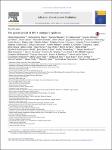The global spread of HIV-1 subtype B epidemic
Magiorkinis, Gkikas
Angelis, Konstantinos
Mamais, Ioannis
Katzourakis, Aris
Hatzakis, Angelos
Albert, Jan
Lawyer, Glenn
Hamouda, Osamah
Struck, Daniel
Vercauteren, Jurgen
Wensing, Annemarie
Alexiev, Ivailo
Åsjö, Birgitta
Balotta, Claudia
Gomes, Perpétua
Camacho, Ricardo J.
Coughlan, Suzie
Griskevicius, Algirdas
Grossman, Zehava
Horban, Anders
Kostrikis, Leondios G.
Lepej, Snjezana J.
Liitsola, Kirsi
Linka, Marek
Nielsen, Claus
Human immunodeficiency virus type 1 (HIV-1) was discovered in the early 1980s when the virus had already established a pandemic. For at least three decades the epidemic in the Western World has been dominated by subtype B infections, as part of a sub-epidemic that traveled from Africa through Haiti to United States. However, the pattern of the subsequent spread still remains poorly understood. Here we analyze a large dataset of globally representative HIV-1 subtype B strains to map their spread around the world over the last 50 years and describe significant spread patterns. We show that subtype B travelled from North America to Western Europe in different occasions, while Central/Eastern Europe remained isolated for the most part of the early epidemic. Looking with more detail in European countries we see that the United Kingdom, France and Switzerland exchanged viral isolates with non-European countries than with European ones. The observed pattern is likely to mirror geopolitical landmarks in the post-World War II era, namely the rise and the fall of the Iron Curtain and the European colonialism. In conclusion, HIV-1 spread through specific migration routes which are consistent with geopolitical factors that affected human activities during the last 50 years, such as migration, tourism and trade. Our findings support the argument that epidemic control policies should be global and incorporate political and socioeconomic factors.
Dateien zu dieser Publikation
Keine Lizenzangabe

